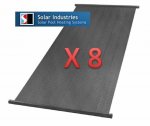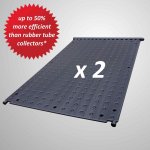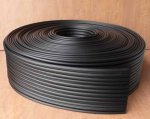And what's the best value system? I'm looking at this now and had sort of settled for the old PVC ribbon-type matting looped across the roof:
[attachment=0:188qbg72]PVC tube.jpg[/attachment:188qbg72]
I am also aware of the much wider, pre-assembled mats like this, although this one is polypropylene and claims better efficiency, lifespan and ease of installation:
[attachment=2:188qbg72]PolyPropylene tubing.jpg[/attachment:188qbg72]
These also caught my eye and claim greater efficiency (50% they claim)and less frictional losses than the traditional PVC type so easier on your pump and you need less area:
[attachment=1:188qbg72]HDPE panel.jpg[/attachment:188qbg72]
That sort of makes sense, to heat a lot of water a little bit at a time is the most efficient way.
$'s per sq.m the PVC is hard to beat, but if the efficiency is true for the HDPE and PP, then it's about the same.
I haven't included vacuum tubes purely because they are expensive, but I would imagine the most efficient.
So what's the latest and greatest? Or can someone open my eyes to something better value?!
[attachment=0:188qbg72]PVC tube.jpg[/attachment:188qbg72]
I am also aware of the much wider, pre-assembled mats like this, although this one is polypropylene and claims better efficiency, lifespan and ease of installation:
[attachment=2:188qbg72]PolyPropylene tubing.jpg[/attachment:188qbg72]
These also caught my eye and claim greater efficiency (50% they claim)and less frictional losses than the traditional PVC type so easier on your pump and you need less area:
[attachment=1:188qbg72]HDPE panel.jpg[/attachment:188qbg72]
That sort of makes sense, to heat a lot of water a little bit at a time is the most efficient way.
$'s per sq.m the PVC is hard to beat, but if the efficiency is true for the HDPE and PP, then it's about the same.
I haven't included vacuum tubes purely because they are expensive, but I would imagine the most efficient.
So what's the latest and greatest? Or can someone open my eyes to something better value?!




